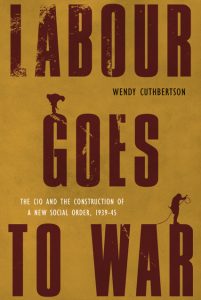In Canadian remembrance of the Second World War one fact rarely rates a footnote: victory was union-made. Wartime membership in trade unions more than doubled.
The U.S.-based Congress of Industrial Organizations first organized a Windsor, Ont. auto parts plant in 1935. It became the fastest-growing labour group in the country.
“A union leader must be an incurable optimist,” one organizer told the CIO’s inaugural national conference in Ottawa just weeks after war’s outbreak in 1939. Their slogan: “C-anada I-s O-rganizing!”
Author Wendy Cuthbertson recounts a story that is rich in anecdotes. An English-born organizer marveled that in Canada, union members drove automobiles and wore fur coats to meetings – “unthinkable in a European union meeting,” she said. Another recalled the gratitude of Polish and Ukrainian immigrants organized in the slaughterhouse trade: “I’d hand them a leaflet and they’d take it and smile and go into the plant and wave out the window. They knew it was about the union, even if they didn’t know what it said.”
Labour Goes To War documents the role of trade unions in the greatest industrial mobilization in our history. Canada’s manufacturing grew two-and-a-half times; the industrial workforce grew to more than 900,000. Ontario was so short of factory hands it issued work permits to 6,800 children under 14.
Unions stood “wholeheartedly behind the empire,” as a Trades and Labour Congress president put it; one former UAW organizer recruited an entire platoon for the Essex Scottish regiment.
Yet Labour Goes To War is not a patriotic romp; even WWII could not erase tension on the shop floor. When labour tried to organize the Massey-Harris company in Toronto, management tried to foil the campaign by granting workers a paid lunch, then fired 76 employees as troublemakers.
Other wartime managers countered union drives with kindness; Dominion Foundries of Hamilton, Ont. invested in employees’ banquets, brass bands, sports teams and a staff newspaper – all money that “could have gone into workers’ wages,” wrote a Steelworkers’ organizer.
Nor did Parliament appear sympathetic to labour’s cause.
With the outbreak of war, Cabinet dusted off the 1907 Industrial Disputes Investigations Act that required unions to submit to federal conciliation before any strike. The resulting cooling-off period could last months – or a full year, in the case of Algoma Steel.
For all that, CIO membership ballooned from 50,000 to 244,000 in war years – an “astounding rate of growth,” writes Cuthbertson. By 1944 the union-backed Co-operative Commonwealth Federation stood first in the national Gallup poll, won government in Saskatchewan and elected 34 members to the Ontario legislature.
It rates more than a footnote.
By Holly Doan
Labour Goes To War: The CIO and the Construction of a New Social Order 1939-45 by Wendy Cuthbertson, UBC Press; 240 pages; ISBN 9780-7748-23432; $32.95






